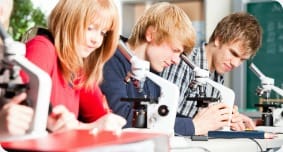Biology Teacher Certification

Biology is everywhere. All living things are made of cells that live, die, and work in perfect harmony to facilitate life. The cycle of life is a complicated concept; one made simpler for elementary, middle, and high school students to grasp by the expert leadership and instruction of certified biology teachers.
Students are inquisitive and curious by nature. Effective biology teachers have intimate knowledge of the unifying principles of biology and understand how to leverage students’ curiosity to devise the most effective, engaging ways to explain the science of living things.
On This Page…
| The Certification Process |
| Topics biology teachers cover |
| Career applications |
| Biology teachers in high demand… |
| Find Schools offering teaching certification programs |
As science teachers, doctors, medical researchers, and other science professionals know, biology is an essential scientific discipline. It is the foundation of some of the world’s most important breakthroughs. While others may get credit and acclaim for their innovative work, all will admit that somewhere along the line they were influenced by a biology teacher who provided them with a useful base of knowledge and nurtured their spirit of exploration and discovery.
Resourceful biology teachers organize field trips to zoos and museums, conduct specimen dissections, and present informative videos and documentaries to make the subject more relevant and easier to understand. The ability to skillfully lead grade school and high school students through complex lessons rarely comes naturally or develops overnight. Teachers complete a rigorous certification process to prove they’ve internalized advanced biology concepts and have the skills necessary to be effective educators.
Certification Process
Getting certified as a biology teacher is a statement of competence. To become certified, teachers must posses at least a bachelor’s degree in biology or education from an accredited college or university and achieve state licensure or certification to teach.
While most certifications and licenses can be earned through a college or university, teachers wishing to pursue certification may earn their credentials through third-party programs, such as those offered through the American Board for Certification of Teacher Excellence (ABCTE) or the National Board for Professional Teaching Standards.
(See requirements for teaching certification in your state, here.)
All states recognize national certifications and many states and school districts provide special benefits to teachers holding national certification such as higher salaries. Additionally, many states allow nationally certified teachers to carry a license from one state to another.
Teachers interested in acquiring national certification must compile a portfolio showing their work in the classroom and pass a written assessment and evaluation of their teaching knowledge. Teachers may become nationally certified in seven disciplines, which are based on the age of the students and, in some cases, subject area.
Topics Biology Teachers Cover
Plants and Animals
There are more than 375,000 species of plants, with more discovered each year. Though it’s nearly impossible to cite each individual species, certified biology teachers need to understand the basic categories, structures, and advanced internal functions common to all plant life.
- Cells are the basic unit of life
- New species and inherited traits are the product of evolution
- Genes are the basic units of heredity
- An organism will regulate its internal environment to maintain homeostasis (balance)
- Living organisms consume and transform energy
Source: Avila, Vernon L. (1995). Biology: Investigating life on earth. Boston: Jones and Bartlett. pp. 11–18. ISBN 0-86720-942-9.
More importantly, effective teachers are able to explain complex processes such as photosynthesis, the Calvin Cycle—plants’ cycle for producing sugar internally—and respiration in engaging, fun ways.
For example, in addition to classroom lectures and demonstrations, teachers can organize field trips to botanic gardens or wildflower preserves. Students learn first-hand from experts in botany and plant biology about the roles leaves, roots, and stems play in the life cycle of a plant and how environmental factors can alter or affect the ability of these parts to function.
Biology classes also explore the behavior of the animal kingdom, spanning the smallest bacteria to the largest mammals. During the certification process, biology teachers must demonstrate that they can clearly explain the nature and origins of microscopic cells and how they contribute to the life cycle of all organisms.
Teachers can develop laboratory experiments and in-class demonstrations such as growing bacteria in a petri dish or conducting animal specimen dissections to provide interactive learning experiences for their students. Using their knowledge of cellular biology and animal physiology, teachers explain step-by-step in their experiments how bacteria grow or how a specimen’s internal structures are built and function within the living being.
Along with micro and cellular biology, teachers pursuing certification will demonstrate knowledge about animal physiology, genetics, and ecology. At a practical level, teachers may bring in guest speakers from a wildlife refuge, the local zoo, or hatchery to support a class discussion about the roles different animals play within their respective ecological environments or about techniques for caring for injured animals.
Human biology and physiology
Knowing and exploring what sets humans apart from the rest of the animal kingdom is a fundamental part of the study of biology. Teachers undergoing certification must display expertise in human anatomy, physiology, and cellular biology and be able to design lessons in class that enable students to make discoveries on their own.
Using their knowledge to clearly explain complex structures such as DNA and the mechanical workings of human anatomy, certified teachers use visual aids such as skeletons and larger-than-scale models of human cells to reinforce class topics.
For example, a teacher may organize an in-class DNA sample experiment. In the activity, students extract DNA from their cheek cells and relate the steps in the procedure to the characteristics of cells and DNA. Students learn about DNA structure and replication during the intervals required for the extraction procedure.
Similar labs and activities can be introduced to bring greater interactivity to the study of other human systems such as the endocrine, cardiopulmonary, and reproductive systems. Certified teachers have the freedom to be creative with their in-class activities to deliver high-touch, high-impact learning initiatives. For instance, a high school teacher may want students to learn how to measure heart rate accurately. Students design and carry out an experiment to test a hypothesis on the effects of a specific activity or stimulus on heart rate, analyze and interpret the data, and present their experiments to the class with hand-made visual aids like posters and flyers.
In addition to classroom learning, enterprising teachers may arrange trips to a local hospital or morgue for a lecture on human diseases or a live anatomy lesson conducted on a cadaver. Cadaver labs offer a unique vantage point of what human biology and anatomy actually looks like on a full scale, helping to solidify students’ understanding of classroom lessons.
Career applications
High school is supposed to prepare students for furthering their education and starting careers. With the rise in popularity of television crime shows, interest in the bourgeoning field of forensic science has reached an all-time high. Teachers undertaking certification must be well prepared to teach the basics of forensic science and demonstrate expert-level understanding of human genetics and cellular biology to effectively lead classroom discussions and experiments.
High school biology classes build on students’ existing knowledge of human microbiology and introduce more advanced concepts along with scientific processes for collecting and analyzing samples.
Certified teachers leverage their extensive knowledge of DNA and other biomarkers to create in-class crime scenarios and structure lessons that help students better understand how to collect, process, and interpret important microscopic materials samples. To augment the experience, teachers may bring students to visit a forensic crime lab to see up close how their in-class lessons translate in a professional environment.
Biology—and science education as a whole—is nearing endangerment in the United States. In fact, a report from the U.S. Department of Education, Office of Postsecondary Education shows that from the 1990-1991 academic year through the 2011-2012 academic year, a majority of states faced a severe shortage in middle and postsecondary level certified biology teachers.
Since the 1950s, government leaders in the US have been calling for additional efforts and funding to support math and science study. Today, like other science, technology, engineering, and mathematics (STEM) disciplines, biology has been widely neglected as a collegiate course of study. The lack of STEM graduates, including biology, has fueled a constant deficit in qualified teachers. With nationwide high school graduation rates hovering around 75%—64% among Hispanics and 62% among African-American students—, the trend seems likely to continue, as the workforce loses prospective teachers long before they even begin college (Education Week. June 13, 2011).
Prospective biology teachers can take advantage of wide-open opportunities in a high-demand field and leverage many of the government-sponsored financial aid options to make attaining certification more feasible and affordable. With a bachelor’s degree from an accredited college or university, and the required state or nationally licensure and certifications, qualified biology teachers can secure positions that pay as much as $70,000 annually in certain areas of the country, even in a down economy (U.S. Bureau of Labor Statistics, May 2011).
Credentialed biology teachers can take advantage of unique fieldwork opportunities to enhance their teaching repertoire in the classroom. For example, Partners in Science gives science teachers the opportunity to undertake actual scientific work at national laboratories during the summer. Those experiences can help greatly shape in-class teacher and student performance, which in turn can help teachers earn greater salaries and leadership opportunities in the future.






